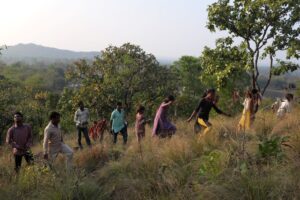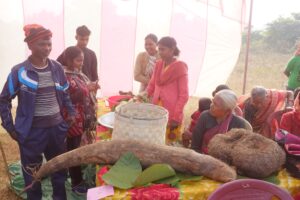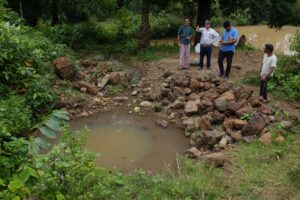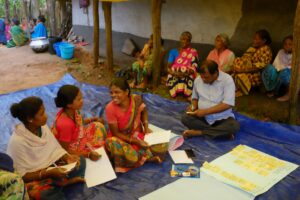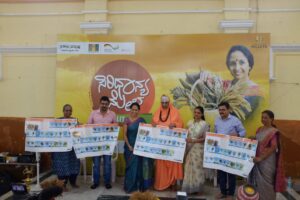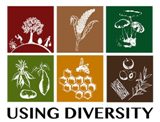The integral historical relationship between the Birhors and forests is reflected in the meaning of the word Birhor – Bir mans Jungle and hor means man, so Birhor means people of the Jungle. The Birhors are one of Chhattisgarh’s notified PVTGs and they are distributed across Bilaspur, Jashpur, Surguja, Raigarh and Korba districts. The UD project is working with 6 Birhor villages of Pali Block and 4 Birhor villages of Podi Block in Korba District. UD project activities in these villages are being facilitated and implemented by Nakul Singh Netam and community fellow Tiharu Ram Birhor.
In the second week of March I travelled to Korba district and along with Nakul Singh Netam I visited the villages of Ganeshpur, Urta, Tadi Chuha, Majgaona and Samelibhata, with Tiharu joining us in Samelibhata. After arriving in Pali we first made our way to Ganeshpur which comprises of 31 Birhor families. We met Phul bai who was busy weaving bamboo baskets and had an interaction with 10-12 villagers comprising men, women and youngsters. A few youngsters facilitated an exercise to identify the different wild vegetables, tubers, mushrooms, fruits and seeds the villagers collect and consume from their surrounding forests. The villagers pointed out that they largely depend on making and selling bamboo baskets and other bamboo items in local markets. A major challenge to their traditional craft and trade is the fact that they are no longer allowed to extract bamboo from forest areas and have to purchase bamboo which negatively impacts their earning. They still depend on a variety of uncultivated food to supplement their diets and they were able to list 8 tubers, 9 mushroom species and a number of wild leafy vegetables which are available mostly during the monsoons.
We then travelled to Urta where we arrived in time to accompany Ram Birhor, Sriram Birhor and Sawan Birhor for a tuber hunt. We made our way through small agricultural fields and makeshift brick kilns which were being used by villagers to meet the brick requirement of Pradhan Mantri Awas Yojna houses; to a patch of open forest known locally as Bhariya Nara. Here Ram and Sriram expertly located and commenced the extraction of the Changrot tuber. While the tuber was close to the surface its extraction took quite a bit of effort involving a khunta and an axe to finally reveal roughly 300 gms of the tuber. It was heartening to see that young men like Sriram were as enthusiastic about tuber and UF collection as more experienced villagers like Ram Birhor. Shortly after returning to the villages Ram offered me some of the recently collected changrot which had been lightly roasted over his wooden fire. Our host Chaitram Birhor who spent most of his spare time weaving a fishing net told us that their community were nomadic forest dependent people but with the gradual destruction of the regions forests they were forced settle in hamlets at the fringes of forest areas. While they do have land, their plots tend to be very small and they eke out a living mostly form bamboo producing a variety of bamboo products based on the need of the season. As revealed by a card sorting exercise with around 30 men and women of the villages, the villagers still collect and consume a large variety of leafy vegetables, mushrooms, tubers, flowers and fruits from surrounding forest areas which the consume with the use of very limited external ingredients. As oil and spices are hard to come by the villagers cook the forest produce using simple techniques comprising mostly boiling and roasting, with a lot of UF being eaten raw as well. The villagers pointed out that of late forest guards have been harassing them a lot claiming that the bamboo they depended on is the property of the Forest Department and that they have no right to collect them. As a result villagers are forced to depend on the limited bamboo stocks of village areas and also have to purchase bamboo from farmers of the area.
It was heartening to see that young men like Sriram were as enthusiastic about tuber and UF collection as more experienced villagers like Ram Birhor. Shortly after returning to the villages Ram offered me some of the recently collected changrot which had been lightly roasted over his wooden fire. Our host Chaitram Birhor who spent most of his spare time weaving a fishing net told us that their community were nomadic forest dependent people but with the gradual destruction of the regions forests they were forced settle in hamlets at the fringes of forest areas. While they do have land, their plots tend to be very small and they eke out a living mostly form bamboo producing a variety of bamboo products based on the need of the season. As revealed by a card sorting exercise with around 30 men and women of the villages, the villagers still collect and consume a large variety of leafy vegetables, mushrooms, tubers, flowers and fruits from surrounding forest areas which the consume with the use of very limited external ingredients. As oil and spices are hard to come by the villagers cook the forest produce using simple techniques comprising mostly boiling and roasting, with a lot of UF being eaten raw as well. The villagers pointed out that of late forest guards have been harassing them a lot claiming that the bamboo they depended on is the property of the Forest Department and that they have no right to collect them. As a result villagers are forced to depend on the limited bamboo stocks of village areas and also have to purchase bamboo from farmers of the area.
We then made our way to Tadi Chuha which comprises of 11 Birhor families where we had a meeting with a gathering of 12 women and 6 men. The villagers listed the rich diversity of uncultivated food that they

collect and consume from community lands and forest areas. I was shown Bhelwa which is a form of wild cashew which the villagers eat raw or roast and eat when ripe. A village elder lamented that how restrictions on the collection of bamboo from forest areas has virtually forced them to become beggars at the mercy of larger farmers in order to get the bamboo they need for their traditional production and trade of bamboo products. They have to beg large farmers for a bamboos and in turn the farmers get them to carry out various tasks in return for which they are allowed to take away a few bamboos for their trade. This village is particularly keen to grow a variety of local crops and they listed the seeds they would like to cultivate and the women were eager to take the responsibility of managing a community seed bank catering to Birhor farmers of the area. In this regard a region wide meeting of women representatives was fixed in order to discuss seed requirement and plan the establishment of a community seed.
We then made our way to Majgaona via Ganeshpur. As a result of our two meetings in Urta and Tadi Chua we reached Ganeshpur only around 1 pm and most villagers had dispersed so we could not have a more detailed interaction than the day before. However, we spent some time in the courtyard of one of the houses where a few villagers were weaving bamboo into baskets. One of the major impressions that this brief halt at a Birhor house in Ganeshpur left on me was that for virtually all members of a Birhor village community villagers working with bamboo and producing a variety of utilitarian bamboo creations is as naturally and routine as daily chores like collecting water, cleaning their courtyards and homes and cooking. The men and women we interacted with in the common courtyard split, weaved and coloured bamboo to create a variety of different kinds of baskets and tools, while tending to babies, sharing a conversation with us and taking a time out to expertly remove a bamboo splinter from a thumb. This raised serious questions about the validity of trying to impose a system based around settled agricultural cultivation on these communities who have such an inseparable link to forests and natural produce of the region they have been inhabiting for thousands of years.
Our next stop Majgaona was home to 13 Birhor families. After a brief rest we accompanied Shankar Birhor to a small hamlet deep inside Kurri Katta forest where he and his son Sunhar had received land titles under FRA around 7-8 years ago. While Majgaona was located in the plains, the Kurri Katta hamlet was located in a hilly forest area. We left our bike where the road ended near white Forest Department concrete  boundary markers and made our way up a rocky forest trail through dense sal forests which were under FD jurisdiction to a tiny hamlet comprising agricultural fields in the heart of the forest with a few small make shift dwellings. The hamlet comprised 3 Lodha (ST), 2 Birhor and one Yadav (OBC) families who were principally engaged in permanent cultivation of their allocated land. Shankar said that he had received the land he now cultivated from his father and that this land was in their family for no less than twenty year. He principally cultivated rice and if he could get hold of the seed he also grew some saag, rahar and a few other crops in small quantities. His son Sunhar was also cultivating his own a little further away and he showed us the land which seemed considerably more than the 1.5 acres which he said he had received the patta for. While the majority of Birhors we had met did not display any long association with settled cultivation Sunhar, his father Shankar and his grandfather before them came across as exceptions who had a family history of over 20 years of permanent cultivation and had even received titles for their land. Sunhar was quite keen to carry out mixed cropping on his land and was looking forward to the establishment of the community seed bank which would make seeds like kodo and kutkki to farmers like him. We returned to Majgaona and the next morning we had an interaction with the villagers which revealed similar problems in accessing bamboo from forest areas as expressed by villagers in the previous villages. While some of the more senior men and women were able to identify a few wild vegetables, tubers, mushrooms and fruits they said that as the forest area is not very close to their village they are not able to get regular access to a large variety of uncultivated food. The women were keen to cultivate a variety of vegetable and other crops and listed a number of different seeds which they would like to be part of the community seed bank. However, further planning and awareness is needed in order to select the seeds that they really need and which they would grow and sustain effectively over a period of time. They agreed to send two women representatives to the meeting at Tadi Chua in order to work towards the establishment of the community seed bank.
boundary markers and made our way up a rocky forest trail through dense sal forests which were under FD jurisdiction to a tiny hamlet comprising agricultural fields in the heart of the forest with a few small make shift dwellings. The hamlet comprised 3 Lodha (ST), 2 Birhor and one Yadav (OBC) families who were principally engaged in permanent cultivation of their allocated land. Shankar said that he had received the land he now cultivated from his father and that this land was in their family for no less than twenty year. He principally cultivated rice and if he could get hold of the seed he also grew some saag, rahar and a few other crops in small quantities. His son Sunhar was also cultivating his own a little further away and he showed us the land which seemed considerably more than the 1.5 acres which he said he had received the patta for. While the majority of Birhors we had met did not display any long association with settled cultivation Sunhar, his father Shankar and his grandfather before them came across as exceptions who had a family history of over 20 years of permanent cultivation and had even received titles for their land. Sunhar was quite keen to carry out mixed cropping on his land and was looking forward to the establishment of the community seed bank which would make seeds like kodo and kutkki to farmers like him. We returned to Majgaona and the next morning we had an interaction with the villagers which revealed similar problems in accessing bamboo from forest areas as expressed by villagers in the previous villages. While some of the more senior men and women were able to identify a few wild vegetables, tubers, mushrooms and fruits they said that as the forest area is not very close to their village they are not able to get regular access to a large variety of uncultivated food. The women were keen to cultivate a variety of vegetable and other crops and listed a number of different seeds which they would like to be part of the community seed bank. However, further planning and awareness is needed in order to select the seeds that they really need and which they would grow and sustain effectively over a period of time. They agreed to send two women representatives to the meeting at Tadi Chua in order to work towards the establishment of the community seed bank.
 Our last stop was the Samelibhatta under Konkona panchayat which comprised of 44 Birhor households and was surrounded by large forest areas. We met community fellow Tiharu Birhor here who had been in Samelibhatta for a few days to carry out surveys and interact with the villagers. Nakul completed a review of the IFR titles received by the villagers which revealed that only 22 households out of 44 had received titles and the land allocated appeared to be quite arbitrary with some villagers having got small patches of a few decimals others had received significantly larger areas when all households had submitted roughly similar claims. There was little transparency in the distribution of IFR titles and villagers had very limited awareness of the FRC, its members and its functioning. The FRC was at the panchayat level and the villagers had little knowledge of its functioning. There was no knowledge of the processes involved in making CFR claims though villagers were keen to understand the process of claiming rights to forest areas on which they depended for a variety of uncultivated food and NTFP. The villagers of Samelibhatta collected a large variety of UF from their forests and as a consequence had good awareness about the different kinds of leafy vegetables, tuber, mushrooms, honey, nectar, fruits and flowers available in the forests of their area. Nakul informed the villagers about future plans to support cultivation of traditional seeds through a community seed bank as well as community meetings and awareness programs to improve understanding of FRA and processes for applying and receiving CFR titles.
Our last stop was the Samelibhatta under Konkona panchayat which comprised of 44 Birhor households and was surrounded by large forest areas. We met community fellow Tiharu Birhor here who had been in Samelibhatta for a few days to carry out surveys and interact with the villagers. Nakul completed a review of the IFR titles received by the villagers which revealed that only 22 households out of 44 had received titles and the land allocated appeared to be quite arbitrary with some villagers having got small patches of a few decimals others had received significantly larger areas when all households had submitted roughly similar claims. There was little transparency in the distribution of IFR titles and villagers had very limited awareness of the FRC, its members and its functioning. The FRC was at the panchayat level and the villagers had little knowledge of its functioning. There was no knowledge of the processes involved in making CFR claims though villagers were keen to understand the process of claiming rights to forest areas on which they depended for a variety of uncultivated food and NTFP. The villagers of Samelibhatta collected a large variety of UF from their forests and as a consequence had good awareness about the different kinds of leafy vegetables, tuber, mushrooms, honey, nectar, fruits and flowers available in the forests of their area. Nakul informed the villagers about future plans to support cultivation of traditional seeds through a community seed bank as well as community meetings and awareness programs to improve understanding of FRA and processes for applying and receiving CFR titles.


